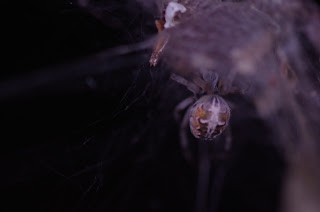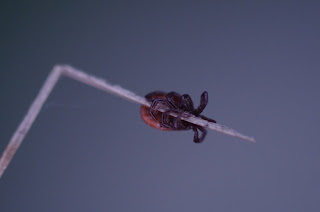A few years ago I found a rather large chrysalis on the ground in my backyard. I didn't know what I had just found, though, because I didn't know what a chrysalis looked like, other than the rather famous monarch butterfly chrysalis, and I had an awful lot of misconceptions about that. But this thing that I found (which I think might have been even before I started photographing bugs in my backyard, but I am not sure. Well, actually, I am fairly sure) looked like an enormous, brown insect with all of its appendages missing. It was a couple inches long, and though I still don't know what kind of insect would have emerged from it, I realize that it was probably a rather large butterfly or moth. I don't remember at what point I figured out what it was, but I have never seen another one. I really wish that I had followed my instinct at the time, and kept it in a jar, because I really wish I knew what had been inside. It was just lying on the ground, in the dirt, and I don't know if that was where the caterpillar that became it had done so, or if it had been somewhere else, on a tree branch, in a bush, somewhere, and had fallen or otherwise been moved by the wind, some animal, or what. It was intact, it hadn't been bored into by anything. I think I may have picked it up, I don't remember, though I probably didn't pick it up with my hands, I would have used a leaf or something. Not knowing what it was, I was wary of it, because it looked like a huge insect, one that could maybe sting; it was pointy at one end like a wasp. Or like, as I now know, a chrysalis. Except that not all chrysalides look like that. There are a lot of different shapes and colors, and that was not the only time I found one that I didn't know what it was, and only realized much later (months, years). Now I have a little bit better idea of what chrysalides are like, and even when I find one that is not anything I have ever seen before, I am able to identify that it is a chrysalis, even if I have no idea what kind it is. It is just another way that my eyes have been opened to what is around me in the world. How many of these things have I seen and never noticed, never thought twice about, never had any idea what kind of wondrous things were happening inside those homely looking forms? But so far twice this year I have found things that I thought were chrysalides, kept them, and got to see what came out. Still, what else is out there that I am missing now?
Which brings me to Backyard Co-Bug of the Day #1.
I think this is actually a cocoon, which would have a chrysalis inside. What is the difference, you ask? Well, a chrysalis is actually the caterpillar itself, or rather a new form it has taken during pupation. The outside of the chrysalis is a hardened skin of the former caterpillar. A cocoon is a structure of silk or I think other things that are attached with silk, inside which the caterpillar becomes a chrysalis. From things I have read, butterfly caterpillars don't make cocoons, only moth caterpillars. So I guess this will be a moth some day. Unless I am completely wrong about what this is. But I am pretty sure that there is a Lepidoptera of some kind developing wings inside there. I am not going to adopt this one, because if it is starting pupation at this time of year I would think that it is going to overwinter in there, and I don't want to mess with its environment and confuse it regarding when to eclose.
Backyard Co-Bug of the Day #2:
Leaf hopper. I chose a second Backyard Bug of the Day today just in case I am wrong and the thing above is not at all related to insects. Even though I am convinced it is. Anyway, I thought this was a nice looking leaf hopper, so here it is.
Today was sunny, but cold (in comparison with the weather of late), and I wasn't able to do my bug walk until quite late in the afternoon, and this time of year, quite late in the afternoon is verging on evening. So even though it had been a sunny day, the whole yard was in shade by the time I went out there. I don't know if I would have found more if I had gone out earlier, but I couldn't, and, well, I guess we'll never know.
When I looked out in the morning it didn't look like there were any morning glories blooming, but by afternoon there were, and there were quite a few that were just beginning to open up. I don't know how that affected their attractiveness to bugs, but the only one that had an insect in it was the partial bloom that had the earwig in it yesterday. But today it was an ant that was inside.
Candy striped leaf hoppers blend in a little bit better this time of year:
Wasp or sawfly, which is kind of the same thing, in that sawflies are a kind of wasp with no stinger. I've just never gotten the knack of identifying which are which.
For a while there fall webworm caterpillars were ubiquitous, but I haven't seen any in a couple of weeks, so it was a surprise to find this one, and that it was rather small. They are social insects for the beginning stages of their lives, so there would not be one that hatched on its own later in the season than the others, I don't think, which makes it odd to find a one, small caterpillar weeks after all of the others have disappeared (to pupate, I would imagine, though I suppose at least some of them were probably prey to something or other).
Tree cricket
I found a LOT of spiders today, so here's a nice dose of Arachnid Appreciation:
.
.
.
.
.
.
.
.
.
.
.
.
Female with egg sac, I think.
I have been trying for weeks to get a good picture of this spider. Still trying...
Six-spotted orb weaver with March fly prey
And one arachnid that I do not appreciate: a tick. I keep showing you these because they are vectors for diseases that can be quite horrible, as in fatal or permanently debilitating, so it is important to know what they look like.
















No comments:
Post a Comment